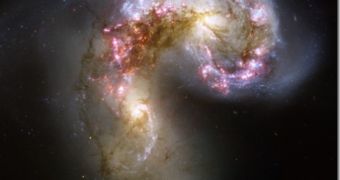LBG-2377 is a galaxy proto-cluster located 11.4 billion light years away from Earth - the most distant galaxies ever observed. In fact, these galaxies are so far away from us, that they appear as they looked when they were in the first days of their lives. Previously, the most distant such galaxy proto-cluster was located only 9 billion light years away from Earth.
"When you observe this far away, you are actually seeing the universe as it was a very long time ago. It is as if a timeline is just sitting out there in front of you. These galaxies represent what the universe looked like well before the Earth existed," said McCue Postdoctoral Fellow in physics and astronomy at University of California, Irvine, Jeff Cooke.
Observations were conducted with the Keck Telescope in Hawaii. Researchers from UCI were actually looking for single galaxies when they first observed the LBG-2377 galaxy proto-cluster. The resolution of the telescope made it appear only as a bright single object, however further analysis revealed multiple light wavelengths that seemed to be consistent with the signature of galaxies interacting through gravitational forces.
Cooke argues that there are at least three large galaxies interacting with each other and two smaller ones.
Because it is so far away from our planet, we have the unique opportunity to view an event that took place more than 11.4 billion year ago, when the universe was only 2.3 billion years old. Our planet, for example, is only 4.5 billion years old.
Not much is known about how galaxies form. It is widely believed that they are created through gravitational interactions and mergers between smaller galaxies, a process that could have began as early as 1.7 billion years after the Big Bang event took place. Mergers are quite frequent even today throughout the universe, and it is believed that they were even more frequent in the past, however detecting such processes at extreme distances is very difficult, especially with galaxies in the first stages of their lives.
Nonetheless, we can detect galaxy clusters, which are very important for the evolution of galaxies, considering that they grow much in the same fashion. We live in a galaxy, which make part of such a cluster, the so-called Local Group, which contains 35 galaxies. However, there are at least 1,000 other galaxies located in the vicinity of the Earth and bundled inside clusters.
"We believe LBG-2377 is a seed that eventually will grow into a massive galaxy cluster. Our finding suggests that this is a monster structure being born in a very bright, catastrophic event with a lot of gas and matter collapsing at once. We are not just seeing one solitary galaxy. We are seeing a bunch of bright galaxies coming together at the dawn of structure formation in the universe," said James Bullock, director of the Center for Cosmology at UCI.

 14 DAY TRIAL //
14 DAY TRIAL //